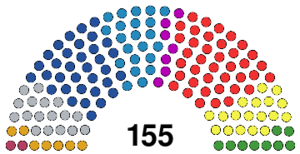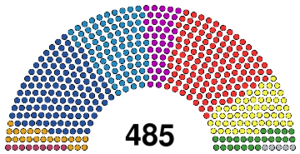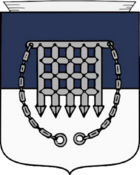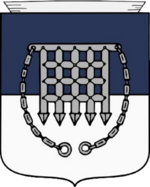Difference between revisions of "Tiomnaidh"
| (2 intermediate revisions by the same user not shown) | |||
| Line 21: | Line 21: | ||
| election1 = 4 August 2023 | | election1 = 4 August 2023 | ||
| leader2_type = [[President of the National Assembly (Hapatmitas)|President of the Assembly]] | | leader2_type = [[President of the National Assembly (Hapatmitas)|President of the Assembly]] | ||
| − | | leader2 = {{nowrap|[[Ken | + | | leader2 = {{nowrap|[[Ken Barnow]]}} |
| election2 = 4 August 2020 | | election2 = 4 August 2020 | ||
| − | | leader3_type = [[ | + | | leader3_type = [[Prime Minister of Hapatmitas|Prime Minister]] |
| leader3 = {{nowrap|[[Doug Macintosh]]}} | | leader3 = {{nowrap|[[Doug Macintosh]]}} | ||
| election3 = 13 April 2024 | | election3 = 13 April 2024 | ||
| Line 41: | Line 41: | ||
:{{color box|#2489BD|border=darkgray}} [[Christian Democrats (Hapatmitas)|Christian Democrats]] (22) | :{{color box|#2489BD|border=darkgray}} [[Christian Democrats (Hapatmitas)|Christian Democrats]] (22) | ||
:{{color box|#B500B5|border=darkgray}} [[Moderate Alliance of Hapatmitas|Moderate Alliance]] (7) | :{{color box|#B500B5|border=darkgray}} [[Moderate Alliance of Hapatmitas|Moderate Alliance]] (7) | ||
| − | :{{color box|#B1B6BD|border=darkgray}} [[Independent politician|Independent]] (17){{noteTag|name="Ind"| | + | :{{color box|#B1B6BD|border=darkgray}} [[Independent politician|Independent]] (17){{noteTag|name="Ind"|The senators with independent affiliation unanimously formed a governing agreement, after the results of the 2023 election, with the ADN-led coalition to avoid a hung parliament in the Senate. It is roughly described as a confidence and supply agreement, though they sit with the government.}} |
'''Opposition (75)''' | '''Opposition (75)''' | ||
:{{color box|#F23030|border=darkgray}} [[Social Democratic Party (Hapatmitas)|Social Democrats]] (39) | :{{color box|#F23030|border=darkgray}} [[Social Democratic Party (Hapatmitas)|Social Democrats]] (39) | ||
:{{color box|#FFDC40|border=darkgray}} [[Progressive Future Party (Hapatmitas)|Progressive Future Party]] (18) | :{{color box|#FFDC40|border=darkgray}} [[Progressive Future Party (Hapatmitas)|Progressive Future Party]] (18) | ||
:{{color box|#6EB861|border=darkgray}} [[Greens' Alliance 50]] (9) | :{{color box|#6EB861|border=darkgray}} [[Greens' Alliance 50]] (9) | ||
| − | :{{color box|#DEA221|border=darkgray}} [[ | + | :{{color box|#DEA221|border=darkgray}} [[Social Solidarity Party (Hapatmitas)|Social Solidarity Party]] (7) |
:{{color box|#B53F63|border=darkgray}} [[People's Action Party (Hapatmitas)|People's Action Party]] (2) | :{{color box|#B53F63|border=darkgray}} [[People's Action Party (Hapatmitas)|People's Action Party]] (2) | ||
| political_groups2 = '''Government (244)''' | | political_groups2 = '''Government (244)''' | ||
| Line 56: | Line 56: | ||
:{{color box|#FFDC40|border=darkgray}} [[Progressive Future Party (Hapatmitas)|Progressive Future Party]] (56) | :{{color box|#FFDC40|border=darkgray}} [[Progressive Future Party (Hapatmitas)|Progressive Future Party]] (56) | ||
:{{color box|#6EB861|border=darkgray}} [[Greens' Alliance 50]] (24) | :{{color box|#6EB861|border=darkgray}} [[Greens' Alliance 50]] (24) | ||
| − | :{{color box|#DEA221|border=darkgray}} [[ | + | :{{color box|#DEA221|border=darkgray}} [[Social Solidarity Party (Hapatmitas)|Social Solidarity Party]] (22) |
:{{color box|#B53F63|border=darkgray}} [[People's Action Party (Hapatmitas)|People's Action Party]] (9) | :{{color box|#B53F63|border=darkgray}} [[People's Action Party (Hapatmitas)|People's Action Party]] (9) | ||
:{{color box|#B1B6BD|border=darkgray}} Non-attached (5) | :{{color box|#B1B6BD|border=darkgray}} Non-attached (5) | ||
:* {{color box|#B1B6BD|border=darkgray}} [[Independent politician|Independent]] (5) | :* {{color box|#B1B6BD|border=darkgray}} [[Independent politician|Independent]] (5) | ||
| − | | voting_system1 = | + | | voting_system1 = Indirect election |
| voting_system2 = Mixed-member proportional representation (MMP) | | voting_system2 = Mixed-member proportional representation (MMP) | ||
| − | | last_election1 = [[2023 Hapatmitasian | + | | last_election1 = [[2023 Hapatmitasian legislative election|7 July 2023]] |
| − | | last_election2 = [[2023 Hapatmitasian | + | | last_election2 = [[2023 Hapatmitasian legislative election|14 July 2023]] |
| − | | next_election3 = [[Next Hapatmitasian | + | | next_election3 = [[Next Hapatmitasian legislative election|By June 2027]] |
| motto = | | motto = | ||
| session_room = File:2011-06-11 01 Parliament House of Sweden (Riksdagshuset) in Gamla Stan, Stockholm.jpg | | session_room = File:2011-06-11 01 Parliament House of Sweden (Riksdagshuset) in Gamla Stan, Stockholm.jpg | ||
| Line 76: | Line 76: | ||
The '''Tiomnaidh''' is the supreme bicameral parliament of [[Hapatmitas]], established in 1950 by the [[Constitution of Hapatmitas]]. It meets at [[Parliament House, Donideann|Parliament House]], Donideann, and is also referred to by the metonym ''Cairninshiel''. The Tiomnaidh consists of the [[Senate (Hapatmitas)|Senate]] and the [[National Assembly (Hapatmitas)|National Assembly]]. There are currently 640 total members in parliament; 155 in the Senate and 485 in the National Assembly. An elected individual in the National Assembly is referred to as a ''Ball Tiomnaidh'' (BT) and elected individuals in the Senate are referred to as senators (''seanairean''). BTs and senators are both elected every four years, with the ability to recall both by their constituents at any time if there is a majority referendum. | The '''Tiomnaidh''' is the supreme bicameral parliament of [[Hapatmitas]], established in 1950 by the [[Constitution of Hapatmitas]]. It meets at [[Parliament House, Donideann|Parliament House]], Donideann, and is also referred to by the metonym ''Cairninshiel''. The Tiomnaidh consists of the [[Senate (Hapatmitas)|Senate]] and the [[National Assembly (Hapatmitas)|National Assembly]]. There are currently 640 total members in parliament; 155 in the Senate and 485 in the National Assembly. An elected individual in the National Assembly is referred to as a ''Ball Tiomnaidh'' (BT) and elected individuals in the Senate are referred to as senators (''seanairean''). BTs and senators are both elected every four years, with the ability to recall both by their constituents at any time if there is a majority referendum. | ||
| − | Members of the Tiomnaidh are direct representatives of the people and are strictly accountable to their electorate. Because | + | Members of the Tiomnaidh are direct representatives of the people and are strictly accountable to their electorate. Because the lower house uses mixed-member proportional representation, it will always result in overhang and leveling seats. This is opposed to the Senate which is elected via indirect election. After the election in [[2015 Hapatmitasian legislative election|2015]], the number of seats in the Senate and National Assembly was raised to 485 in the lower house and 155 in the upper house. While the [[Cabinet of Hapatmitas|Council of Ministers]] is responsible for answering to both houses of the Tiomnaidh, members of the body derive from the lower house and hence ''de-facto'' answer to the National Assembly. While both houses have equal power within the Tiomnaidh, the National Assembly is considered ''de facto'' superior to the Senate, with more legislative abilities regarding government such as impeachment and appointments. However, the Senate still has the power to send back legislation to the lower house if they subjectively see fit as a majority, though this is rare. |
== Etymology == | == Etymology == | ||
| Line 83: | Line 83: | ||
== History == | == History == | ||
=== Membership and structure === | === Membership and structure === | ||
| − | The number of seats in the Tiomnaidh has changed since its establishment in 1950 due to the proportional representation electoral system and varied electoral reforms. In 1950 there were provisionally 50 seats in both houses, increasing to 72 BTs and 48 senators in 1951 after the [[1951 Hapatmitasian | + | The number of seats in the Tiomnaidh has changed since its establishment in 1950 due to the proportional representation electoral system and varied electoral reforms. In 1950 there were provisionally 50 seats in both houses, increasing to 72 BTs and 48 senators in 1951 after the [[1951 Hapatmitasian legislative election|first legislative election]], 109 BTs and 68 senators after the [[1963 Hapatmitasian legislative election|1963 election]], 140 BTs and 95 senators after the [[1975 Hapatmitasian legislative election|1975 election]], 240 BTs and 102 senators after the [[1991 Hapatmitasian legislative election|1991 election]], 360 BTs and 120 senators after the [[2007 Hapatmitasian legislative election|2007 election]], and 485 BTs and 155 senators as of [[2015 Hapatmitasian legislative election|2015]]. |
| − | Until 2011, both houses of the Tiomnaidh were led by a president and five vice presidents, which formed the chambers' presidium respectively. However, after the passage of an electoral [[Elections and Representation Act 2010 (Hapatmitas)|restructuring act]] and the [[2011 Hapatmitasian | + | Until 2011, both houses of the Tiomnaidh were led by a president and five vice presidents, which formed the chambers' presidium respectively. However, after the passage of an electoral [[Elections and Representation Act 2010 (Hapatmitas)|restructuring act]] and the [[2011 Hapatmitasian legislative election|2011 legislative election]], each house was limited to one president and two vice presidents. However, this provision was later reversed in 2013 by an amendment to the act; it returned the other three vice presidents and eliminated the impartiality of the president and vice presidents of each chamber, allowing for more democratic representation and accurate statistics regarding the Tiomnaidh. The act also eliminated leveling seats, though this would later be reversed. |
| − | In 2014, the [[Legislative Rectifications Act 2014 (Hapatmitas)|Legislative Rectifications Act]] was passed and signed into law. After taking effect following the [[2015 Hapatmitasian | + | In 2014, the [[Legislative Rectifications Act 2014 (Hapatmitas)|Legislative Rectifications Act]] was passed and signed into law. After taking effect following the [[2015 Hapatmitasian legislative election|2015 legislative election]], the powers of all caucuses within both houses changed. Minority opposition parties in the National Assembly who did not reach a certain threshold were no longer allowed the authority to call for fast-track motions that accelerated legislation to be sent to the Senate; the largest opposition party, as well as their partners, was now allowed to formally form shadow cabinets, though the practice has been conducted since 1991; and, parliamentary groups were now more clearly defined for statistical reasons. Among other changes, the legislation also created the [[Advocate Generals Bureau (Hapatmitas)|Advocate Generals Bureau]], an independent agency affiliated with the Tiomanidh to investigate complaints, misconduct, and other forms of irresponsible or undemocratic actions regarding BTs and senators. |
| + | |||
| + | In early 2023, discussions for an independent and unified electoral and boundary agency began. After the [[2023 Hapatmitasian legislative election|2023 legislative election]], the [[Elections and Boundaries Act 2023 (Hapatmitas)|Elections and Boundaries Act 2023]] was assented into law on 14 October 2023, establishing the unified [[Elections and Boundary Commission (Hapatmitas)|agency]]. The legislation formally reversed the provision in the Elections and Representation Act 2010 regarding eliminating overhang and leveling seats. Because the electoral and boundary agencies were merged, the act also created new electoral regulations, provided by an independent panel employed by the Tiomnaidh/ The [[2027 Hapatmitasian legislative election|2027 legislative election]] will become the first election to be administered under these new regulations. | ||
== Composition == | == Composition == | ||
Latest revision as of 00:31, 2 May 2024
Tiomnaidh of Hapatmitas | |
|---|---|
13th Tiomnaidh | |
| Type | |
| Type | Bicameral |
| Houses | Senate National Assembly |
| History | |
| Founded | 4 August 1950 |
| Preceded by | National Congress |
New session started | 5 August 2023 |
| Leadership | |
Patrick Marwick since 4 August 2023 | |
Ken Barnow since 4 August 2020 | |
Doug Macintosh since 13 April 2024 | |
Tom McIntyre since 27 October 2023 | |
| Structure | |
| Seats | 640 155 (Senate) 485 (National Assembly) |
 | |
Senate political groups | Government (80)
Opposition (75)
|
 | |
National Assembly political groups | Government (244)
Opposition (241)
|
| Elections | |
Senate voting system | Indirect election |
National Assembly voting system | Mixed-member proportional representation (MMP) |
Senate last election | 7 July 2023 |
National Assembly last election | 14 July 2023 |
Next general election | By June 2027 |
| Meeting place | |
 | |
| Parliament House, Cairninshiel, Donideann | |
| Constitution | |
| Constitution of Hapatmitas | |
 |
|---|
| This article is part of a series on the politics and government of Hapatmitas |
The Tiomnaidh is the supreme bicameral parliament of Hapatmitas, established in 1950 by the Constitution of Hapatmitas. It meets at Parliament House, Donideann, and is also referred to by the metonym Cairninshiel. The Tiomnaidh consists of the Senate and the National Assembly. There are currently 640 total members in parliament; 155 in the Senate and 485 in the National Assembly. An elected individual in the National Assembly is referred to as a Ball Tiomnaidh (BT) and elected individuals in the Senate are referred to as senators (seanairean). BTs and senators are both elected every four years, with the ability to recall both by their constituents at any time if there is a majority referendum.
Members of the Tiomnaidh are direct representatives of the people and are strictly accountable to their electorate. Because the lower house uses mixed-member proportional representation, it will always result in overhang and leveling seats. This is opposed to the Senate which is elected via indirect election. After the election in 2015, the number of seats in the Senate and National Assembly was raised to 485 in the lower house and 155 in the upper house. While the Council of Ministers is responsible for answering to both houses of the Tiomnaidh, members of the body derive from the lower house and hence de-facto answer to the National Assembly. While both houses have equal power within the Tiomnaidh, the National Assembly is considered de facto superior to the Senate, with more legislative abilities regarding government such as impeachment and appointments. However, the Senate still has the power to send back legislation to the lower house if they subjectively see fit as a majority, though this is rare.
Etymology
The present-day application of the word tiomnaidh derives from the Old Cantuath word tiodeachnaidhean, meaning "council of ten." The word itself originated from the decision-making and war councils of the confederal cantons during the period of the Rinnfriu Confederation. The modern-day word was first recorded in use in 1464.
History
Membership and structure
The number of seats in the Tiomnaidh has changed since its establishment in 1950 due to the proportional representation electoral system and varied electoral reforms. In 1950 there were provisionally 50 seats in both houses, increasing to 72 BTs and 48 senators in 1951 after the first legislative election, 109 BTs and 68 senators after the 1963 election, 140 BTs and 95 senators after the 1975 election, 240 BTs and 102 senators after the 1991 election, 360 BTs and 120 senators after the 2007 election, and 485 BTs and 155 senators as of 2015.
Until 2011, both houses of the Tiomnaidh were led by a president and five vice presidents, which formed the chambers' presidium respectively. However, after the passage of an electoral restructuring act and the 2011 legislative election, each house was limited to one president and two vice presidents. However, this provision was later reversed in 2013 by an amendment to the act; it returned the other three vice presidents and eliminated the impartiality of the president and vice presidents of each chamber, allowing for more democratic representation and accurate statistics regarding the Tiomnaidh. The act also eliminated leveling seats, though this would later be reversed.
In 2014, the Legislative Rectifications Act was passed and signed into law. After taking effect following the 2015 legislative election, the powers of all caucuses within both houses changed. Minority opposition parties in the National Assembly who did not reach a certain threshold were no longer allowed the authority to call for fast-track motions that accelerated legislation to be sent to the Senate; the largest opposition party, as well as their partners, was now allowed to formally form shadow cabinets, though the practice has been conducted since 1991; and, parliamentary groups were now more clearly defined for statistical reasons. Among other changes, the legislation also created the Advocate Generals Bureau, an independent agency affiliated with the Tiomanidh to investigate complaints, misconduct, and other forms of irresponsible or undemocratic actions regarding BTs and senators.
In early 2023, discussions for an independent and unified electoral and boundary agency began. After the 2023 legislative election, the Elections and Boundaries Act 2023 was assented into law on 14 October 2023, establishing the unified agency. The legislation formally reversed the provision in the Elections and Representation Act 2010 regarding eliminating overhang and leveling seats. Because the electoral and boundary agencies were merged, the act also created new electoral regulations, provided by an independent panel employed by the Tiomnaidh/ The 2027 legislative election will become the first election to be administered under these new regulations.
Composition
Notes
- ↑ The senators with independent affiliation unanimously formed a governing agreement, after the results of the 2023 election, with the ADN-led coalition to avoid a hung parliament in the Senate. It is roughly described as a confidence and supply agreement, though they sit with the government.
